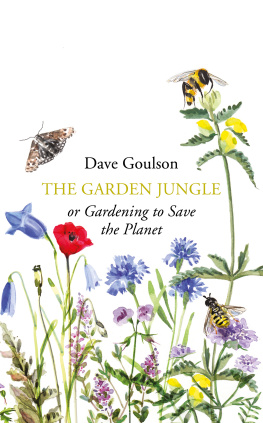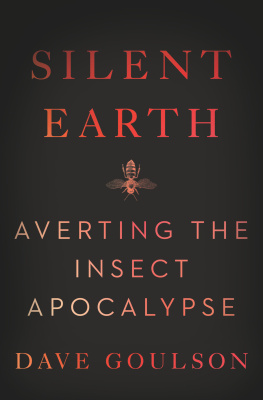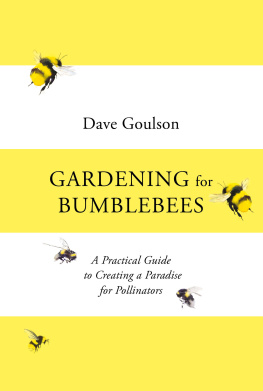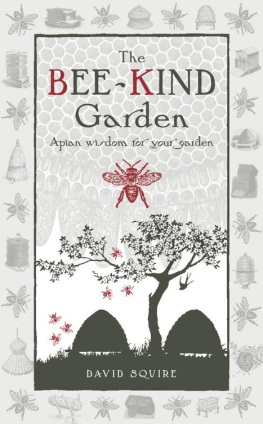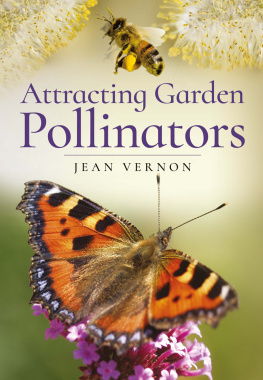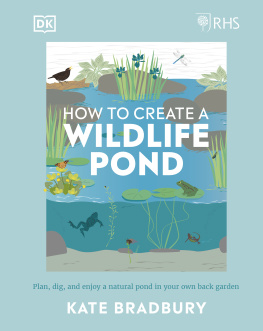

The Garden Jungle
or
Gardening to Save the Planet
Dave Goulson

Contents
About the Author
Dave Goulson studied biology at Oxford University and is now Professor of Biological Sciences at the University of Sussex. He has spent the last twenty years studying bumblebees, and has published over 250 scientific articles on their biology. He founded the Bumblebee Conservation Trust in 2006. He is the author of the Sunday Times bestseller, A Sting in the Tale, which was shortlisted for the 2013 Samuel Johnson Prize, A Buzz in the Meadow and Bee Quest.
Also by dave goulson
A Sting in the Tale
A Buzz in the Meadow
Bee Quest
For Gaia, Goddess of the earth
Prologue
This book is about the wildlife that lives right under our noses, in our gardens and parks, between the gaps in the pavement, and in the soil beneath our feet. Wherever you are right now, the chances are that there are worms, woodlice, centipedes, flies, silverfish, wasps, beetles, mice, shrews and much, much more, quietly living within just a few paces of you. Even a tiny garden can contain many hundreds of species of wild insects, small mammals and plants. The lives of these creatures are just as fascinating as those of the more glamorous large mammals or tropical birds that you might see in wildlife documentaries, and are often less familiar. What is more, because these creatures live all around us rather than in some distant, steamy jungle, we can encounter them up close and watch their trials and tribulations, from birth to courtship, copulation and death, all happening right in front of our noses. I recall Chris Packham once saying that he would rather spend ten minutes lying on his tummy watching a woodlouse than an hour watching a glossy television programme about lions in the Serengeti. This book is a celebration of the lives of the little creatures that live in our gardens. I hope that it may also give you some ideas as to the many practical steps that we can all take to increase this diversity, and to encourage even more wonderful creatures into our lives. This can easily be combined with growing lots of healthy, pesticide-free and zero-food-miles fruit and veg, for gardens and allotments can be remarkably productive, places where humans and wildlife can thrive together in harmony rather than conflict. Gardens provide us with a place where we can reconnect with nature and rediscover where food comes from. If we embrace this, we gardeners might just save the planet, and in so doing save ourselves. So join me, in a trip to explore the jungle that lurks just outside your back door
1
Plants in Profusion
To make mulberry muffins
Ingredients: 110g butter, 250g plain flour, 250g caster sugar, 2 eggs, 125ml milk, 2 tsp baking powder, tsp salt, 250g mulberries
- Grow mulberry tree. It may take ten years or more to fruit, since they are slow-growing trees. If you are in a hurry, buy a house with an established one in the garden.
- Preheat oven to 180C. Grease a muffin tin. Mix baking powder, flour and salt.
- Cream butter and sugar until light and fluffy. Add eggs and beat. Add milk and flour mixture, beat. Stir in mulberries.
- Fill muffin tin full. Cook for 25 minutes.
These are absolutely delicious, gooey, moist muffins. Definitely worth the ten-year wait.
For millennia we humans lived as hunter-gatherers in small bands, knowing nothing of the world beyond our tribal territory, dealing only with what we could see and touch and taste. We harvested berries and nuts, caught fish and game, and later grew crops. For us, the Earth was flat. We did not know or worry about global issues such as overpopulation, pollution or changing climate, and we probably did not try to plan years ahead. Perhaps as a result, our brains do not seem to be well suited to grasping big-picture issues, to understanding and reacting to ponderous global changes that may take decades or centuries to have their effect. Certainly our track record in planning ahead for the long-term well-being of our planet leaves much to be desired.
Even now in the twenty-first century, when our understanding of the universe is vastly increased, the big issues that face us seem beyond our personal scope, unmanageable and intractable. Anything I might do to prevent climate change, stop the felling of rainforests, or prevent the hunting of rhinos for the supposedly medicinal properties of their horns seems trivial and ineffective. As a conservationist, it is all too easy to feel helpless and despondent. Much of my personal inspiration to battle on has always come from the small-scale victories I can achieve in my own garden, for that is a little corner of Earth that I can control, that is small enough for my brain to comprehend, and where I can make things right. After a sometimes tedious day in my office at the university, perhaps spent firefighting the never-ending email onslaught as most of us seem to do in place of actually doing anything useful, I gain huge inspiration and enjoyment from going into my garden and getting my hands into the soil. I plant seeds and nurture them as they grow, watering, mulching, weeding, harvesting, composting, and working with the cycle of the seasons. This is the scale on which I work best, when I can see and feel the effects of my actions. For me, saving the planet starts with looking after my own patch.
Since leaving my family home at nineteen I have had six successive gardens over thirty-odd years, starting with a pocket-handkerchief rectangle behind an excruciatingly ugly concrete ex-council house in Didcot, and eventually graduating to my current slightly unkempt but delightful two-acre garden in the Weald of East Sussex. Each one has been very different, in terms of soil, aspect and the plants I inherited, but in all I have tried to gently steer the garden to support the most wildlife possible, learning as I went. In particular, I have tried to encourage bees and other pollinators by providing them with a banquet of flowers and, wherever I can, some quiet places to nest or breed or hole up for the winter.
Wildlife gardening is easy. Plants grow themselves, and bees and butterflies will find them when they flower. Herbivores will appear, slugs, snails, weevils, leaf beetles and caterpillars, and in turn predators will arrive to eat them. Dig a pond and a huge range of plants, insects and amphibians will miraculously and spontaneously turn up, somehow sniffing out the unclaimed water from miles away. Successful wildlife gardening is as much about what you dont do as what you do. This is not to say that a wildlife garden has to be untidy. Many imagine a wildlife garden as an unruly tangle of brambles, nettles and dandelions, and it is true that a laissez-faire garden like this will certainly attract a lot of wildlife, but it is also perfectly possible to have a tidy and beautiful garden that is teeming with life (though tidiness does of course tend to require a little more work). Tidy or unkempt, a tiny courtyard or verdant rolling acres, your garden is probably already home to hundreds, maybe thousands, of wild species.
Next page
